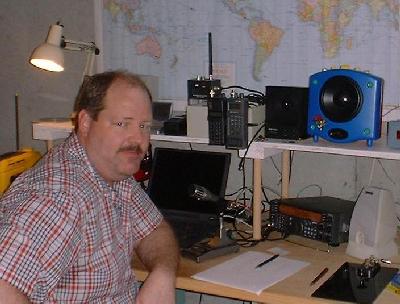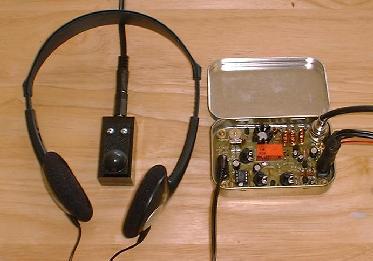 |  |
 |  |
The Shack... For those of you who haven't heard before, there was a time when the radio shack was the place on a ship where the radio was located. And the operator's nickname was always "Sparks"--from the day's when spark gaps were used. Of course times change, but a lot of radio enthusiast still refer to the area where they keep their radios as their "shack". And today, if you say you're going to the "Radio Shack", most people assume you're on your way to the mall![]() .
.
These days I have a corner of the basement for my radios and my workbench.

I've been luck to own a number of great radios over the years. Because I only have limited space and money, I've traded some of these radios in and evolved my shack.
My main rig is a Kenwood TS-570D(G). It's a ham transceiver with general coverage shortwave reception. I love this radio! The automatic antenna tuner and direct frequency entry sets it apart from most of the other radios I looked at in the same price class. Most of my operation is code with an occasional voice QSO (especially interesting special event stations). I plan to try some of the digital modes down the road.
I'm also interested in QRP (low-power) operation. I recently built a FOXX-3 (from Kanga) transceiver. This is a small, crystal controlled, QRP transceiver housed in an Altoids tin. Below is a picture of a QRP station featuring the FOXX-3, headphones, and a miniature code key. Add a battery and an antenna and you're on the air!

The importance of Morse code is almost a religous argument among hams. Many say code is dead, but I have to disagree. If you want to throw together a five transistor transceiver that can work stations all over the US, it will almost certainly operate CW. Even with a no-code technican license, when you search for DX on the VHF bands (6 meters or 2 meters) you soon begin to envy the CW ops at the bottom of the band who always seem to be beeping away. It didn't take me long after getting my no-code technican license to realize I needed to learn the code. A month later I was back taking the upgrade exams.
I have several other radios that make it to the shack from time to time, but these days I'm more concerned with keeping things organized that with having the most knobs, glowing dials, and digital readouts I can manage.
I have a G5RV antenna mounted from my deck in the backyard. I've been impressed with it's performance considering it's only 15' to 20' off the ground.
For VHF and scanning I use a discone antenna. When I first used the discone with my scanners, I was disappointed in it's performance. Then I added a two-way splitter. When I connected a ground to the splitter the discone really came alive! I spent a while arguing with an "expert" on one of the newsgroups about whether the discone should be grounded or not--but all I can say is that it makes a difference. And the most important piece of advice you'll ever get about antennas is to experiment and find what works best.
I enjoy building and tinkering. I feel more comfortable with a soldering iron than with a key. There's almost always a couple of projects in progress.
I've got a pretty nice bench with some older, but functional, test equipment. I've got an o'scope, an AF signal generator, an RF signal generator, several meters, a frequency counter, a dummy load and watt meter, an isolation transformer, and (most recently) an MFJ antenna analyzer. I've even got a tube tester!
I enjoy working with older radios as long as I can get them to the point where they spend more time on the air than on the bench. I love saving old (and sometimes fairly new) receivers from the garbage pile...
My Home Page / E-Mail Me
Sign My Guestbook
![]() View My Guestbook
View My Guestbook
Copyright © 1999-2001 by Jim McClanahan All rights reserved.